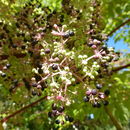More info for the term:
coverControl: Devil's walkingstick is killed by aerosol applications of
glyphosate at rates of 1.50 to 2.25 pounds per acre (0.56-2.52 kg/ha)
applied three times at 2-week intervals from mid-August to mid-September
[
35]. Korostoff [
17] reported that devil's walkingstick is controlled
by cutting and application of herbicide to the stump. The most
effective treatment reported by Loftis [
20] is injection of stems larger
than 2 inches in diameter with herbicide; basal sprays were ineffective
on his study sites.
Establishment: Devil's walkingstick populations are maintained only on
disturbed sites. When the overstory cover becomes thick enough, devil's
walkingstick declines. Defoliation by gypsy moth infestation in
Pennsylvania and Maryland resulted in an increase in stems per acre of
devil's walkingstick, due both to injury of devil's walkingstick
ramets and to release by removal of overstory [
12]. Mowing or cutting
of stems results in vigorous sprouting of new ramets from underground
rhizomes and is recommended for maintenance of vigorous stands [
14,
15].
Fire also produces appropriate disturbances and stem damage, and could
be used to maintain devil's walkingstick stands [
36].

